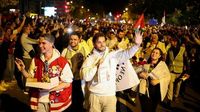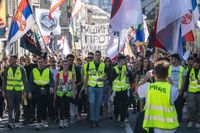Tens of thousands of Serbians poured into the streets of Novi Sad on November 1, 2025, marking the somber anniversary of a tragedy that shook the nation to its core: the collapse of a railway station canopy that killed 16 people a year prior. But this was no ordinary commemoration. The gathering became a powerful focal point for a student-led protest movement that has, over the past year, grown into a formidable challenge to President Aleksandar Vucic’s grip on power and the direction of the country itself.
The roots of the movement can be traced back to November 1, 2024, when the newly renovated canopy at Novi Sad’s central railway station suddenly gave way, burying commuters beneath tons of steel and concrete. The disaster was immediately attributed by many to governmental negligence, endemic corruption, and what critics described as shadowy deals with Chinese construction firms involved in the station’s refurbishment. The sense of outrage was palpable—Serbia has a long history of anti-government demonstrations, but the scale and energy of the response to this tragedy felt different from the start.
According to Sky News, students quickly organized sporadic demonstrations demanding accountability. Their message was clear: this was not just an accident, but a consequence of a government that had, in their view, valued cost-cutting and cronyism over public safety. As the months passed, the protests evolved. What began as a call for justice for the 16 victims became a broader movement demanding snap elections, democratic reforms, and a reckoning with what many saw as Serbia’s deep-seated culture of impunity.
The movement’s momentum was impossible to ignore. As Associated Press reported, the protests “seriously shook President Aleksandar Vucic and his firm grip on power.” The government responded with a mix of concessions and crackdowns. In January 2025, the prime minister and the rest of the government resigned—a rare gesture in Serbian politics—but critics noted that, to date, no one has been tried, convicted, or sentenced for the disaster. Some officials faced charges, but the lack of accountability only fueled further anger.
In the lead-up to the anniversary, the students organized a 16-day march across Serbia, dedicating one day to each of the lives lost in Novi Sad. Their journey became a symbol of resilience and unity. “We have made a huge difference,” Luka, a student protester, told Sky News. “We can see a lot more people are politically active. I can see a lot more people are willing to change, and that’s a huge step forward.” Another demonstrator, Andjela, declared, “We are going to continue to fight against our corrupt government.”
The marchers were welcomed with open arms in villages and towns along their route. Locals offered food and medical care, and a war veteran walking with the students summed up the mood: “These kids are fighting for values that are normal throughout the world. We have laws, but they are not respected, they exist only as dead letters on paper. Crime has prevailed here, especially within state institutions and we must fight against that.”
Yet the government’s response remained combative. President Vucic threatened mass arrests if the commemoration turned violent and insisted his supporters would soon stage an even larger rally in Novi Sad. When pressed by a television reporter about the opposition gathering, Vucic scoffed, “What is happening in Novi Sad? Is some soccer match being played?” He added, “Many will be disappointed due to excessive expectations from the rally. There will be no change of government.”
Authorities appeared determined to make life difficult for the protesters. Thousands who marched from Belgrade to Novi Sad were forced to sleep outdoors in the town of Indjija after the local mayor, a Vucic ally, refused them access to a sports hall and warned residents not to provide them with food or water, as Associated Press detailed. On October 31, the state railway company abruptly halted all trains between Belgrade and Novi Sad, citing a bomb threat—a move eerily reminiscent of previous protest-eve disruptions. Many suspected it was an attempt to keep demonstrators from reaching the city.
Despite these obstacles, the turnout in Novi Sad was massive. Crowds filled the city’s streets and squares, staging rallies at multiple locations—a strategy organizers hoped would make it harder for riot police to intervene. Over the past year, hundreds of protesters have been arrested at major demonstrations, including two huge rallies in Belgrade, with each side blaming the other for sporadic outbreaks of violence. Most protests, however, have remained peaceful, driven by a spirit of determination rather than confrontation.
The government’s heavy-handed tactics have not gone unnoticed. The protests have shone a harsh spotlight on media freedom in Serbia. News organizations critical of the government or simply reporting on the protests have found themselves targeted. Igor Bozic, news director at the N1 news channel, told Sky News, “The president repeated so many times we are terroristic media, we are enemy of the state and he is targeting us, not only N1 but by also pointing out reporters and anchors, and claiming they’re people who don’t like this country. Immediately that produces a huge number of threats to us because that kind of narrative comes directly from the first man of the country.”
The European Union, which Serbia aspires to join, has also voiced concerns. Just last week, the EU criticized Serbia for failing to enact sufficient reforms to protect independent media. Still, government officials have pushed back. Nemanja Starovic, Serbia’s minister for European integration, defended the government’s approach, arguing, “I wouldn’t say they [anti-government media outlets] are a threat to national security, but on the other hand you have illegal activities and 25,000 illegal political gatherings that are not suppressed but nevertheless they are illegal, and then you have media outlets that are not just covering but participating in gathering and organising such events. That is something we cannot support. That is the fact of life we are witnessing here.”
As the anniversary commemoration unfolded, President Vucic did announce a national day of mourning beginning at midnight on October 31, 2025. But for many, this gesture rang hollow in the absence of real accountability or reform. The student movement, meanwhile, remains undeterred. Their actions have brought unprecedented visibility to issues of corruption, government transparency, and the rule of law in Serbia.
The events in Novi Sad have set the stage for a new chapter in Serbia’s ongoing struggle for democracy and justice. Whether the movement’s momentum will translate into lasting change remains to be seen, but one thing is certain: the voices of those demanding a better future for Serbia are louder—and more united—than ever before.

